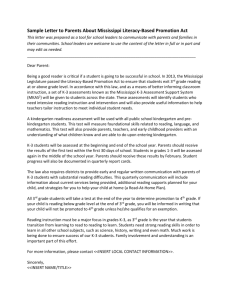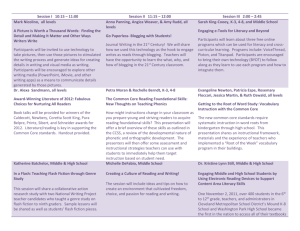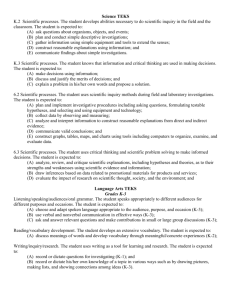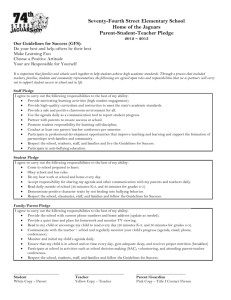KDE Program Review for K-3 Kentucky Department of Education
advertisement
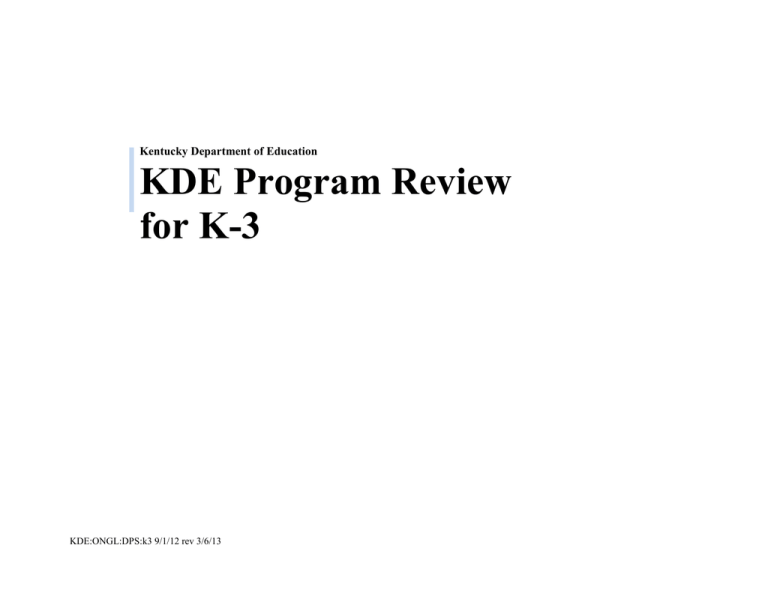
Kentucky Department of Education KDE Program Review for K-3 KDE:ONGL:DPS:k3 9/1/12 rev 3/6/13 Curriculum & Instruction K-3: CURRICULUM AND INSTRUCTION Demonstrator 1. Student Access All students have equitable access to highly effective curriculum and instruction. Limited/No implementation a) Teachers rarely collaborate on planning for meeting the needs of all students. Needs Improvement a) Teachers informally share ideas and strategies for instruction. Proficient Distinguished a) Teachers consistently collaborate a) Teachers collaborate school wide to ensure each student has access to with others on their team or learning experiences that are grade level to plan instructional necessary and appropriate for units, including common attaining and even progressing assessments and supplemental beyond curricular standards. activities to ensure that each Parent, community and higher student has access to the education partners are regularly curriculum and access to involved in helping design supports necessary to attain the engaging and relevant learning curriculum. experiences that may extend beyond the school walls. b) Students have limited access to the b) Students have some access to the b) Students have access to a variety b) Students have access to and use a equipment and materials they need equipment and materials they need of equipment and materials that variety of equipment and materials to attain the curriculum. There is to attain the curriculum. Instruction are relevant and necessary to designed to meet their individual inconsistency or inequity is not often adjusted based on support their needs. Instruction is needs and enhance their learning throughout the building. Instruction needs and/or students are not given continually revised and students experiences. Instruction is is not revised to meet individual opportunities or instructed in how are instructed in how to use the continually revised and students are student needs. to use the feedback in an effective feedback to improve their work. instructed in how to use the way in order to improve student feedback to improve their work. work. Evidence: Rationale: Next Steps: KDE:ONGL:DPS:k3 9/1/12 rev 3/6/13 2 Curriculum & Instruction KDE:ONGL:DPS:k3 9/1/12 rev 3/6/13 3 Curriculum & Instruction Demonstrator 2. Aligned and Rigorous Curriculum An aligned and rigorous curriculum provides access to Kentucky Core Academic Standards (KCAS) for all students as defined by state and national standards. Limited/No implementation Needs Improvement Proficient a) Curriculum is not aligned to state standards. a) Curriculum is only topically aligned to state standards and/or does not include pacing recommendations. a) The curriculum is vertically and horizontally aligned to state standards and fully addresses the rigor/intent of the standards. It includes specific pacing recommendations. b) There is no plan/policy on the use of instructional time/curriculum implementation. b) Inadequate instructional time is b) Adequate instructional time is provided in the schedule to provided for teachers to plan and effectively plan and enact the fully enact the curriculum. curriculum; OR instructional time is not prioritized and effectively used for addressing the curriculum. Distinguished a) A rigorous curriculum is aligned, vertically and horizontally, to state and national standards with a focus on 21st Century Skills taught in the context of core subjects and interdisciplinary themes. Pacing guides are present and updated annually based on implementation data and lessons learned. b) Ample instructional time is provided and utilized effectively by all teachers to address the curriculum. Flexibility is built into the schedule to further address student misconceptions as well as to provide enrichment opportunities to ensure student success. Evidence: Rationale: Next Steps: KDE:ONGL:DPS:k3 9/1/12 rev 3/6/13 4 Curriculum & Instruction Demonstrator 3. Instructional Strategies All teachers implement research-based instructional strategies that include characteristics of highly effective teaching and learning for all students. Limited/No implementation Needs Improvement Proficient Distinguished a) Instructional strategies throughout a) Instructional strategies vary widely a) Teachers routinely use studenta) Teachers routinely use highly the school are predominantly throughout the school. Students effective, student-centered and centered and evidence-based teacher-centered and involve whole work in small groups, based on evidence-based instructional instructional strategies that class or inflexible groupings of student needs. strategies that include classroom include classroom discussions, students. discussions, questioning, agequestioning, and learning tasks appropriate inquiry-based activities that promote critical thinking and learning tasks that promote 21st skills. Teachers scaffold instruction. Students work in Century Skills. Students work in flexible, collaborative groups based flexible, collaborative groups based on student needs and learning on student interests, choice, needs styles. and learning styles. b) Teachers rarely focus lessons on defined/standards-based learning targets. b) Teachers may share a learning b) Teachers consistently involve b) Teachers and students cotarget but do not necessarily ensure construct/review the learning students in defining and/or the target is connected to intended targets daily. Students can writing learning targets (using standards and/or that success articulate what they are learning to clear and precise language) that criteria for meeting the target is do and how they will know they are essential to standard understood by all students. are successful. They regularly selfattainment. Students can assess and engage in peerdescribe what it takes to achieve assessment strategies. Students also the target (the success criteria). track their progress with learning Instruction is planned to directly targets throughout instructional ensure that students meet the units and have multiple and varied targets and ultimately have opportunities to demonstrate opportunities to demonstrate learning. understanding of the standard as a whole. c) Students are not engaged in cross- c) Students are not regularly engaged c) Students are engaged in crossc) Students are consistently engaged curricular instruction. Instruction in cross-curricular instruction. in a variety of cross-curricular curricular instruction that is remains segmented by content Integration happens occasionally instructional activities that are deliberate, culturally responsive, areas without regard to natural and and doesn’t appear to be deliberate, culturally responsive, and includes handsKDE:ONGL:DPS:k3 9/1/12 rev 3/6/13 5 Curriculum & Instruction authentic integration. intentional. on, authentic and applied learning experiences. and include hands-on authentic learning experiences. Evidence: Rationale: Next Steps: KDE:ONGL:DPS:k3 9/1/12 rev 3/6/13 6 Curriculum & Instruction Demonstrator 4. Kentucky Systems of Intervention (KSI) /Response to Intervention (RtI) A school establishes and uses a systematic, comprehensive system that addresses accelerated learning, achievement gaps, highly-effective instruction, readiness to learn and student transitions. A school provides a seamless framework, using state and federal funding, that addresses academic and behavioral needs, that is accessible to all students. Limited/No implementation Needs Improvement Proficient Distinguished a) A KSI/ RtI decision making protocol has not been established. a) A KSI/ RtI decision making a) A KSI/ RtI decision making a) A KSI/ RtI decision making protocol has been established but is protocol has been established and protocol has been established and ineffective and not always is used to make decisions based on is always used to make decisions equitably applied. student needs. that are based on individual student needs. b) Universal screening is not utilized to potentially identify students for intervention. b) Universal screening is used to b) Universal screening is used to b) Universal screening is used to determine students for intervention, determine students for intervention determine students for intervention but the data is not used to and the data is used to determine services; diagnostic assessment determine intervention services. intervention services. and/or supplemental report data is used to further inform the individual student’s intervention services. c) Instruction is not research-based. c) Instruction is not always researchbased, or is not always accessible to all students. Services attempt to provide interventions for student achievement but are not always effective or are inconsistent. d) Intervention teams are not d) Intervention team members meet established, or members do not and discuss programmatic and regularly meet to discuss student behavioral needs, but the follow needs. Academic and behavioral through is ineffective or intervention services are ineffective inconsistent. and inconsistent. KDE:ONGL:DPS:k3 9/1/12 rev 3/6/13 c) Highly effective instruction c) Highly effective instruction includes tiered services that includes tiered services that provide intervention to increase provide a comprehensive system of student achievement, is researchinterventions to maximize student based, aligned to standards as well achievement, is research-based, as across tiers, and accessible to all aligned to standard as well as students. across tiers, and designed to meet the individual needs of all students d) Intervention team members meet to d) Intervention team members discuss academic and behavioral routinely meet to discuss the needs of students and adequately academic and behavioral needs of address those needs. each intervention student and effectively meet their needs. Team members communicate intervention plans and progress with students and families. 7 Curriculum & Instruction e) Progress monitoring is not used. e) Progress monitoring is used e) Progress monitoring data (as e) Progress monitoring occurs on a infrequently, or is not used to required in SB 1 2009, including routine schedule. Data collected inform decisions about instruction. specifically diagnostic data) informs decisions about instruction informs decisions about instruction and individual student learning. and individual student learning. Instruction is adjusted based on the Instruction is adjusted based on the progress monitoring data. progress monitoring data. f) The school has no communication f) The school has very limited regarding interventions with the communication regarding families of those students identified interventions with the families of for intervention. those students identified for intervention. The family is only notified of intervention services. f) The school regularly communicates f) The school consistently intervention services and progress communicates intervention services with the families of those students and progress with the families of identified for intervention. Family those students identified for communication is focused on intervention. Family improving student learning. communication is focused on improving student learning. Families provide regular input and reflection into the student’s intervention plan, services, and/or progress. Evidence: Rationale: Next Steps: KDE:ONGL:DPS:k3 9/1/12 rev 3/6/13 8 Formative & Summative Assessment K-3: FORMATIVE AND SUMMATIVE ASSESSMENT Demonstrator 1. Assessments Teachers should use multiple assessment processes to inform, guide, develop and revise instructional strategies and curriculum to enhance to student learning and achievement. Limited/No implementation Needs Improvement a) Teachers do not use assessment a) Teachers inconsistently and/or data to monitor student progress or irregularly use informal guide instruction. assessments to monitor progress and/or guide instruction. b) Teachers rarely use assessment methods to gather data about student understanding. Teachers rarely reflect on instruction, nor make adjustments to support each student’s learning. Proficient Distinguished a) Teachers embed day-to-day/week- a) Teachers collaborate to consistently embed day-toto-week/informal assessments to day/week-to-week/informal monitor progress and guide assessments to monitor progress instruction (aligned to the and guide instruction (aligned to school’s systemic plan/policy). the school’s systemic plan/policy). b) Teachers use limited assessment b) Teachers use multiple and b) Teachers collaborate and analyze methods to systematically gather multiple and developmentally developmentally appropriate data about student understanding of assessment methods (e.g., appropriate assessment methods learning targets, reflect on formative, screening, diagnostic, (e.g., formative, screening, instruction, and make adjustments interim, benchmark, summative) to diagnostic, interim, benchmark, to instruction. systematically gather data about summative) to systematically student understanding of learning gather data about student targets, reflect on instruction, and understanding of learning targets, make adjustments to instruction. reflect on instruction, and make adjustments to support each student’s learning. Evidence: Rationale: Next Steps: KDE:ONGL:DPS:k3 9/1/12 rev 3/6/13 9 Formative & Summative Assessment Demonstrator 2: Expectations for Student Learning Teachers communicate consistently high expectations and use common standards for student learning in K-3. Limited/No implementation Need Improvement Proficient Distinguished a) Students and families are not provided models and/or descriptions of intended learning targets. a) Students and families are rarely a) Students and families are provided a) Students and families are provided given models and descriptions of guidance with descriptive and clear with clear models and intended learning targets. models of the intended targets to be descriptions of the intended Descriptions may be unclear and/or mastered to enable students to targets to be mastered. incomplete. define the clear criteria for their success. b) Teachers rarely provide feedback. b) Teachers provide primarily b) Teachers provide timely, learning b) Teachers provide timely, learning evaluative feedback (e.g., grades, target-focused descriptive feedback target-focused descriptive scores, generic comments such as to students and provide guidance feedback to students and provide ‘well done’ or ‘try harder’) rather on how to apply the feedback. guidance on how to apply the than descriptive and focused Sufficient time is given regularly to feedback to enhance student feedback that can actually assist the students to refine their thinking, work. student in improving their work. enhance their learning, and improve their work based on the intended learning targets. Evidence: Rationale: Next Steps: KDE:ONGL:DPS:k3 9/1/12 rev 3/6/13 10 Professional Development K-3: PROFESSIONAL DEVELOPMENT 1. Opportunities Professional development opportunities are planned with teacher learning needs in mind and in response to data available about school needs, teacher practice and student learning. Limited/No implementation Needs Improvement Proficient Distinguished a) There is no professional development action plan. a) A professional development action a) The professional development a) The professional development plan is developed but not fully action plan is linked to the action plan is linked to the implemented and/or appropriate for Comprehensive School Comprehensive School K-3 instruction. Improvement Plan (CSIP), is Improvement Plan (CSIP) and is appropriate for K-3 instruction. appropriate for K-3 instruction, and is revisited throughout the year to assess the implementation and fidelity and to make needed changes. b) Teachers have limited access to job-embedded professional development. b) Teachers have adequate access to job-embedded professional development. b) Teachers have access to and participate in job-embedded professional development (e.g., distance learning, conferences, workshops) that supports research-based K-3 practices. b) Teachers base their job-embedded professional development choices on research, self-reflection and review of student outcome data. Evidence: Rationale: Next Steps: KDE:ONGL:DPS:k3 9/1/12 rev 3/6/13 11 Professional Development 2. Participation Teachers are leaders in their professional community, and guide/lead professional development that meets the needs of the professional learning community. No implementation Needs Improvement Proficient Distinguished a) Teachers and administrators do not a) Teachers and administrators are participate in professional learning passive members of professional communities. learning communities. a) Teachers and administrators actively participate as members of professional learning communities that focus on research-based K-3 practices, planning of instruction, analysis of assessment data/student work and student performance. a) Teachers and administrators actively participate as members and leaders of professional learning communities that focus on highly effective and researched-based K-3 practices, planning of instruction, analysis of assessment data/student work and student performance to impact both the K-3 program, as well as individual student needs. b) K-3 teachers and administrators have no contact with external partners. b) K-3 teachers and administrators regularly collaborate with the community, local business partners, as well as early learning communities and secondary partners. b) K-3 teachers and administrators are provided time in the school schedule, a stipend and/or professional development credit for collaboration with community, business, early learning and postsecondary partners. b) K-3 teachers and administrators have limited contact with external partners. Evidence: Rationale: Next Steps: KDE:ONGL:DPS:k3 9/1/12 rev 3/6/13 12 Administrative/Leadership Support & Monitoring K-3: ADMINISTRATIVE/LEADERSHIP SUPPORT AND MONITORING Demonstrator 1. Policies and Monitoring School leadership establishes and monitors implementation of policies, provides adequate resources, facilities, space and instructional time to support highly effective K-3 instructional programs. No implementation Needs Improvement Proficient Distinguished a) School leadership/SBDM committee neither monitors nor allocates sufficient time and resources that are necessary to support an effective K-3 program. a) School leadership/SBDM a) School leadership/SBDM committee monitors and/or committee continually monitors allocates time and resources the availability of resources in without consideration of specific effort to thoughtfully allocate needs for an effective K-3 program. sufficient blocks of instructional time and developmentally appropriate resources needed to support an effective K-3 program. a) School leadership/SBDM committee continually utilizes input from stakeholders to organize and monitor the availability of outside resources in effort to effectively and equitably allocate the necessary time and resources needed to support a highly effective K-3 program. b) SBDM committee does not establish formal policies. b) SBDM committee establishes policies for the K-3 program, however the policies are not datadriven and are not routinely monitored or reassessed. b) SBDM committee establishes and enacts a process to at least annually analyze data related to the implementation and impact of policies and practices specifically for the K-3 program. b) SBDM committee involves teachers, parents and community stakeholders annually in the analysis of data to make recommendations for continuous improvement in the K-3 program. Policies and practices for a highly effective K-3 program are revisited and revised annually based on multiple sources of impact data. c) School council/leadership never or c) School council/leadership rarely communicates with parents communicates with parents about about the K-3 program. the K-3 program. c) School council/leadership communicates with parents and community frequently about the K-3 program. c) A variety of sources, including technology and media resources, are regularly used to communicate current information about the K-3 program with parents and community. KDE:ONGL:DPS:k3 9/1/12 rev 3/6/13 13 Administrative/Leadership Support & Monitoring d) School leadership/SBDM does not d) School leadership/SBDM establish policies that promote best establishes policies that promote practice in the K-3 program. best practice in the K-3 program. Implementation is inconsistent or may not be fully functioning. d) School leadership/SBDM d) School leadership/SBDM establishes and maintains policies maintains and stabilizes policies that promote best practice in the Kthat promote best practice in the K3 program (e.g., critical 3 program (e.g., critical attributes: continuous progress, attributes: continuous progress, developmentally appropriate developmentally appropriate educational practices, multiage and educational practices, multiage multiability classrooms, authentic and multiability classrooms, assessment, qualitative reporting authentic assessment, qualitative methods, professional teamwork, reporting methods, professional and positive parent involvement) teamwork, and positive parent involvement) Evidence: Rationale: Next Steps: KDE:ONGL:DPS:k3 9/1/12 rev 3/6/13 14 Administrative/Leadership Support & Monitoring Demonstrator 2. Principal Leadership Principals are the primary leaders of all K-3 program efforts and support teacher leadership through shared leadership strategies and actions. No implementation Needs Improvement Proficient Distinguished a) The principal lacks understanding of the specific elements and attributes that contribute to an effective K-3 program. a) The principal supports the K-3 program but does not effectively monitor the implementation and impact on student learning and access to appropriate learning experiences and supports. a) The principal works a) The principal intentionally creates a structure to promote and collaboratively with teachers to empower teacher leaders to define define, support, and continuously improve the K-3 program. The and continuously improve the K-3 principal regularly facilitates K-3 program. The principal collaborates team meetings in order to monitor with the teachers/teacher leaders regularly to analyze program and and support all K-3 program efforts. student data, providing feedback and support for ongoing improvements that promote the success of every K-3 student and all K-3 program efforts. b) The principal does not promote an environment that supports a professional learning community. b) The principal facilitates b) The principal participates fully in b) The principal participates fully in, professional learning regarding the facilitates and leads research-based, and facilitates research-based K-3 program. professional learning in relation on-going professional learning in to the K-3 program. relation to the K-3 program. c) There are no policies in place to assess assignment of staff to meet student needs. c) The principal establishes policies c) The principal makes decisions for the assignment of staff based on related to staff assignment based needs of students. on student needs determined by student trend data. c) The principal makes decisions related to staff assignment based on student needs determined by trend data around student performance and staff abilities. Evidence: Rationale: KDE:ONGL:DPS:k3 9/1/12 rev 3/6/13 15 Administrative/Leadership Support & Monitoring Next Steps: KDE:ONGL:DPS:k3 9/1/12 rev 3/6/13 16
